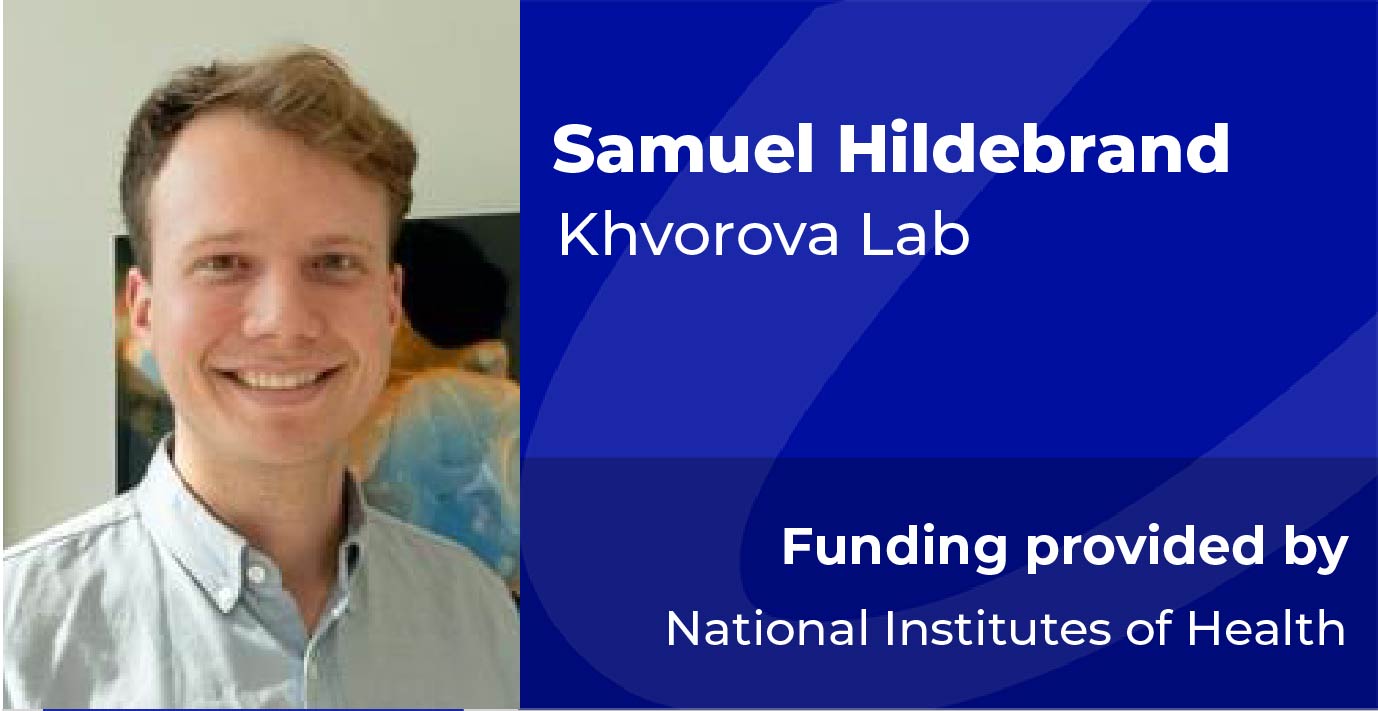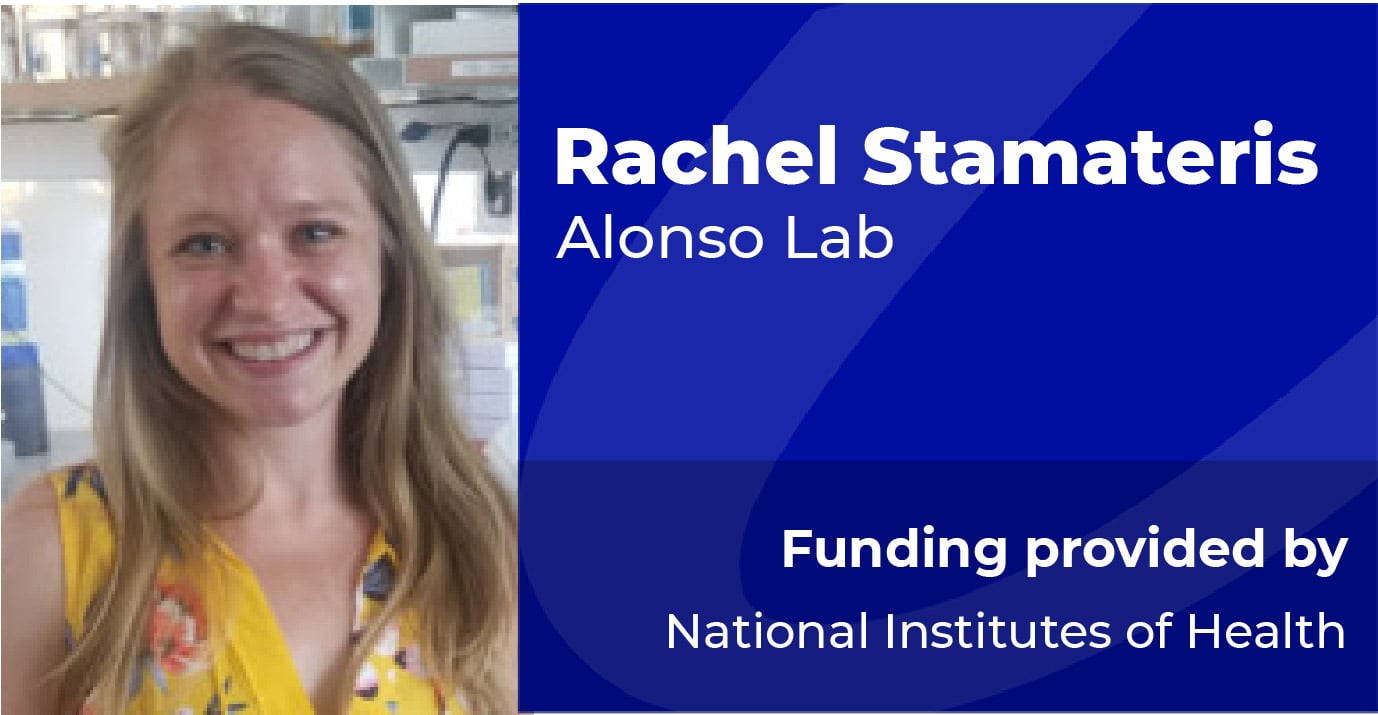Page Menu
Interdisciplinary Graduate Program
Many complex biological and biomedical problems are best analyzed through an interdisciplinary combination of approaches that may include classical genetics, molecular genetics, genomics/proteomics, biochemistry, and light and electron microscopy. The Interdisciplinary Graduate Program (IGP) supports and encourages graduate student training in interdisciplinary approaches to biomedical research. The IGP is characterized by a flexible graduate curriculum that is tailored to the specific needs of individual students and encourages rapid initiation of full time thesis research. The 141 distinguished faculty that participate in the program are affiliated with 16 basic science and clinical departments at the Medical School.
REQUIREMENTS FOR SPECIALIZATION
All Basic Biomedical Science students must complete the core curriculum as well as electives required by their program. IGP does not require specific advanced courses; rather, advanced coursework, journal clubs, and other enrichment activities that can be selected from those offered by any Morningside Graduate School of Biomedical Sciences program. Selections are tailored to the requirements of each student and are determined after discussion between the faculty advisor and the student. In general, a minimum of three graded elective courses of 2-4 credits each are required. As part of the students' training, they are also required to present their research data once a year in a seminar series designed to give students an opportunity to learn scientific information and presentation skills.
View PhD Program Schedule | View Courses
PROGRAM DIRECTORS

OUR FACULTY
Inherent in the philosophy of the IGP, as well as the fact that the majority of Morningside Graduate School of Biomedical Sciences faculty are members of the IGP, our faculty are involved in research areas that span the breadth of biomedical research. Consequently, studies on biochemical mechanism, molecular structure, virology, immunology, cancer biology, and neurobiology, are among their research areas.
View the affiliated faculty listing for the Interdisciplinary Graduate Program.
STUDENT EXPERIENCE
Numerous IGP students have been honored with a Weintraub award; a nationwide award given to less than 15 students each year based on the quality, originality, and significance of their research. The Weintraub award has been called the "Nobel" of thesis awards by Nobel Laureate and IGP faulty member Dr. Craig Mello. Previous IGP award winners include Alla Grishok (2002), Pedro Batista (2010) Emma Watson (2014), and Colin Conine (2014).
The IGP program sponsors a weekly seminar program where students present their research to a diverse audience of students, postdocs, and faculty.
STUDENT SPOTLIGHT
Katya Makeyeva, PhD'23
Interdisciplinary Graduate Program

While a student at UMass Chan, Makeyeva investigated how small RNA pathways regulate gene expression of reproductive cells. She worked in the lab of Nobel Laureate Craig Mello, PhD, Howard Hughes Medical Institute Investigator, the Blais University Chair in Molecular Medicine and distinguished professor of RNA therapeutics and molecular medicine.
Learn more about Katya Makeyeva, PhD'23
OUR STUDENTS IN THE NEWS
Getting Results…
-
PhD student Valeria Sanabria, MD, won the Zelda Haidak Scholarship in Cell Biology, which was established to enhance training for women pursuing research careers in cell biology. Her research is focused on studying gene expression at the transcriptional level.
Read more
, Graduate School of Biomedical Sciences, Faculty, Student, Research, Interdisciplinary, RNA Therapeutics Institute, Latest News, Athma Pai,
-
Nicholas Harper, a PhD candidate in the Interdisciplinary Graduate Program, has received a prestigious award from the National Cancer Institute to study cell death as it relates to cancer therapies.
Read more
, Graduate School of Biomedical Sciences, Cancer Center, Faculty, Student, Award, Research, Interdisciplinary, Michael J. Lee, Program in Systems Biology , Latest News, Top Stories,
-
PhD candidate John Girgenrath has received a competitive award from the Eunice Kennedy Shriver National Institute of Child Health and Human Development to conduct fertility research.
Read more
, Graduate School of Biomedical Sciences, Student, Craig C. Mello, Award, Research, Interdisciplinary, RNA Therapeutics Institute, Program in Molecular Medicine, Latest News, Mello Lab, Top Stories,
EXTERNAL AWARDS FOR RESEARCH TRAINING (CURRENT)
-
Infants with Rett syndrome (Rett) are born with loss-of-function mutations in the gene encoding MeCP2, a global regulator of gene expression. MeCP2 dysfunction in the brain severely affects neurons, leading to neurodevelopmental deficits of varying severity that manifest after 6 months of age. Current treatments can manage some symptoms, but correcting MECP2 mutations would more effectively restore patients’ quality of life. CRISPR gene editing has made this approach conceivable. Among CRISPR technologies, prime editing is the most flexible, utilizing an RNA-guided Cas9 nuclease fused to reverse transcriptase to “search and replace” mutations in post-mitotic cells. Thus, prime editing is a strong candidate for Rett treatment. Yet, prime editor has only been delivered to neurons via lentivirus (not clinically relevant), and its editing efficiency is low.
Previous work demonstrates that mRNA-based delivery of gene editors is simple, safe, and supports robust editing in liver. Lipid nanoparticle-encapsulated mRNA delivers to brain, but efficiency of mRNA-based prime editing in neurons, and how it compares to that of lentiviral delivery, is undetermined. In addition, chemically modifying the guide RNA of other CRISPR systems can protect against nuclease-mediated degradation and improve gene editing rates in cells. The Watts lab recently developed a method to synthesize long, chemically modified prime editing guide RNA (pegRNA), something that had previously been unfeasible. However, the effect of pegRNA modification on prime editing efficiency has not yet been tested.
With support from Drs. Jonathan Watts (nucleic acid chemistry), Michael Green (Rett neurobiology), Erik Sontheimer (prime editor biology), Scot Wolfe (gene regulation), and Athma Pai (bioinformatics), this project will establish and chemically optimize mRNA-based prime editors to correct MECP2 mutations and reverse their phenotypes in neurons. Aim 1 will establish baseline effectiveness of mRNA-based prime editor (vs. lentiviral) against the most common Rett mutation (a missense mutation) and two clinically severe nonsense mutations in HEK cells expressing each mutant MeCP2, patient-derived induced pluripotent stem cells (iPSC), and iPSC-derived neurons. This Aim will also probe neurons pre- and post-editing to understand the molecular phenotypes of each MECP2 mutation and extent to which editing reverses them. Aim 2 will iterate on the Watts lab’s pegRNA assembly method to optimize pegRNA yield and synthesis time, and identify editing-compatible pegRNA modification patterns using in vitro and in cellulo assays. The effect of pegRNA modifications on editing MECP2 mutations will be tested and optimized in HEK cells, iPSCs, and iPSC-derived neurons, as in Aim 1. Molecular phenotypes of prime edited vs. unedited neurons will also be characterized as in Aim 1. This work will offer insight into how MECP2 mutants affect severity of Rett phenotypes in neurons and inform development of a prime-editing platform to treat any form of Rett as well as other neurological disorders. The training provided from this research will prepare the fellow for a productive career in the gene editing and neuro-therapeutics field.
Read more
-
Non-alcoholic fatty liver disease (NAFLD) currently effects around 30% of Americans and costs the U.S approximately $103 billion annually. However, the standard of care remains lifestyle changes and liver transplantation with currently no FDA approved therapies. NAFLD often correlates with obesity which is rising in both developed and developing nations. Mammalian target of rapamycin complex 2 (mTORC2) is emerging as a central hub for carbohydrate and lipid metabolism, with its activation having been linked to NAFLD in mice. These recent studies have highlighted a role for mTORC2 modulation during high-fat diets in mice, where hepatic mTORC2 ablation provides a protective effect against high-fat induced hepatic steatosis. However, the dietary supplements that have been most attributed to the rise of NAFLD in humans are carbohydrates, specifically fructose. While protective effects of mTORC2 ablation in the liver during high-fat diet have been investigated, its impact on high-carbohydrate diets has been neglected. Here, I will examine the ability for mTORC2 to protect against high-carbohydrate induced hepatic steatosis, as has previously been seen in the context of high-fat diets. Mechanistically, I will investigate the role by which hepatic mTORC2 regulates carbohydrate derived acetyl-CoA synthesis and utilization, subsequently promoting the pathogenesis of NAFLD. I will accomplish this by examining two distinct acetyl-CoA producing enzymes: ACLY and ACSS2. Not only will I investigate mTORC2’s role in regulating both ACLY and ACSS2 through phosphorylation, but also for the first time, investigate mTORC2 loss in an acute setting using an auxin degron system, which is a plant based endogenous degradation tag. With the completion of this proposed work, I strongly believe that a more detailed and mechanistic understanding of hepatic signaling, and metabolism will be obtained, providing targets which could ultimately be used to treat NAFLD and other metabolic diseases.
Read more
-
Trisomy 21 is thought to broadly impact the development, transcriptome, and activity of many neural cell types. However, the extent to which DS alters each is conflicted and potentially overestimated by variability not due to trisomy. Reducing variability through “trisomy silencing” will increase the power to detect legitimate effects of trisomy 21 in different neural cell types, when during development changes occur, and which remain correctable.
Read more
-
Duchenne muscular dystrophy (DMD)—a fatal inherited muscular dystrophy—is caused by loss of Dystrophin, a protein that maintains muscle integrity. Corticosteroids slow DMD progression but cause side effects. Addressing the root cause of DMD may improve patient health without needing corticosteroids. Many DMDcausing mutations disrupt the dystrophin mRNA reading frame, resulting in non-functional protein. Strategies that skip the out-of-frame exon to restore the reading frame and produce semi-functional protein for improved muscle function could correct 64% of DMD mutations. FDA-approved antisense oligonucleotide drugs can skip select exons in dystrophin mRNA, but require lifelong infusions and only work in a small group of patients. Using CRISPR to edit dystrophin would require just one treatment. CRISPR-mediated ablation of splice sites to cause exon skipping can increase Dystrophin in DMD models. Yet, editing in unintended tissues is a safety concern for Cas9 therapies. An ideal platform for DMD would restrict editing to muscle tissue to maximize therapeutic benefit. Efforts to achieve tissue-specific editing often rely on delivery via adeno-associated viruses (AAVs) with tissue tropism; yet, it is rarely absolute. Tissue-specific editing was recently achieved using tissue-specific miRNAs to regulate expression of Cas9 inhibitors [anti-CRISPR (Acr) proteins] via miRNA target sites (TS) in the 3’ UTR of Acr mRNA. When the platform is systemically delivered to mice via AAV, Acr-TS targeted by liver-specific miRNA allows editing only in the liver. Unlike tissue-specific promoters, this Acr-TS strategy could be adapted to one or multiple muscle tissues affected in DMD, as long as muscle-specific (myo)-miRNA can repress an Acr. With support from Erik Sontheimer (CRISPR, Acr), Eric Olson (DMD), Wen Xue (in vivo CRISPR delivery), Phillip Zamore (miRNA), Guangping Gao (AAV), and Zhiping Weng (bioinformatics), this proposal seeks to develop a muscle-specific editing platform to treat DMD. The myo-miRNA, miR-1, can repress an Acr in muscle cell lines to achieve muscle-specific editing. To fine-tune specificity of editing in muscle tissues for DMD, Aim 1 will test the ability of myo-miRs varying in abundance and muscle-type specificity to repress Acr and drive muscle-specific editing in mouse cell lines. The myo-miR construct supporting highest muscle-specific editing will be delivered to a DMD mouse model, and in vivo muscle function as well as dystrophin exon skipping, Dystrophin protein, and miRNA level in muscle tissues and liver will be measured. Aim 2 will test the compatibility of additional Cas9 orthologs in the Acr-TS system to enable targeting of more sequences, and develop a single AAV delivery system for improved safety. An Acr inhibiting the Cas9s to be tested has been identified. The ability of miR-1 to repress this Acr and drive muscle specific editing by each Cas9 will be tested in cells. A single vector encoding the AcrTS system will be designed and packaged into AAV, and muscle-specific editing will be compared to a dual AAV system in mice. This work will develop a flexible, safe, muscle-specific CRISPR platform with the potential to be used for any combination of muscle tissues to treat patients with DMD, or other genetic muscle disorders.
Read more
-
The goal of this project is to determine the mechanism by which cell death results from transcriptional inhibition. The consensus model in the field posits that cell death following transcriptional inhibition results from the loss of specific mRNA species and subsequent loss of protein. By targeting such a core cellular process, transcriptional inhibition is thought to overwhelm cellular control and lead to unavoidable cell death. This death process, defined as Accidental Cell Death (ACD), is not controlled by the cell, and does not result from the use of defined effector molecules. Contrary to the conventional model, we found that, rather than induce ACD, cell death following transcriptional inhibition results from a previously undescribed regulated apoptotic signal. Furthermore, we found that RNA Pol II degradation, rather than loss of mRNA production, resulted in cell death. Our data suggests a new model, whereby degradation of Pol II induces a signal that leaves the nucleus and is received by the mitochondria to initiate apoptosis. To identify genes that regulate a pro-apoptotic signal following transcriptional inhibition, we performed a genome-wide CRISPR screen. Genome-wide CRISPR screens often fail to identify death regulatory genes, making it difficult to elucidate mechanisms of cell death. To overcome this, we developed a novel experimental strategy that allowed us to identify genes whose knockout modulated the cell death rate following transcriptional inhibition. Based on the results of our screen, in Aim 1 we will test the hypothesis that the alternative splicing regulator PTBP1 facilitates altered splicing and nuclear export of regulatory pre-mRNA, and that this activity is required for cell death following transcriptional inhibition. We will use live cell microscopy to establish the functional role of PTBP1 nuclear export. We will use SLAM-seq and RIP-seq to quantify PTBP1 activity following transcriptional inhibition. Our screen also identified BCL2L12 as the critical apoptotic effector gene for transcriptional inhibition. In Aim 2, we will test the hypothesis that BCL2L12 activates apoptosis following transcriptional inhibition in an isoform-specific manner. We will perform a series of functional genetics experiments to characterize the role of BCL2L12 in the apoptotic response. By describing a new mechanistic model by which transcriptional inhibition induces cell death, we will improve our understanding of how to effectively use transcriptional inhibitors therapeutically. Ultimately, we hope our work will improve our ability to predict which patients will best respond to transcriptional inhibitors and help identify novel treatment strategies.
Read more
-
Alzheimer’s Disease (AD) is the most common neurodegenerative disease in the world and the 6th leading cause of death in the United States. Despite significant effort, current AD therapies are highly limited in both number and efficacy. Hope for new therapeutic interventions has emerged from recent genome-wide association studies (GWAS), which have identified genes whose mutations are linked to altered AD susceptibility. One of the strongest and most reproducible genetic associations with altered AD risk are members of the Membrane Spanning 4a (MS4A) gene family. In fact, current genetic data suggest that MS4A polymorphisms account for approximately 10% of all AD cases. However, a limited understanding of MS4As has hindered the development of therapies targeting these proteins. Single cell transcriptional profiling has revealed that the Ms4a genes genetically linked to AD are selectively expressed in a subset of microglia, the resident innate immune cells of the central nervous system. Furthermore, MS4A-positive subsets of microglia display a phenotype similar to microglia seen in neurodegenerative disease states, necessitating inquiry into the role of MS4As in microglia. We found that Ms4a-positive microglia are enriched for phagocytic machinery versus Ms4a-negative microglia, and animals deficient for individual Ms4a family members have significantly reduced expression of genes important for phagocytosis compared to wild-type (WT) animals. Microglial phagocytosis is a dynamic process by which brain debris, dying cells, unwanted synaptic connections, and toxic molecules are eliminated and disruption of this process is thought to underlie numerous neurological disorders, including AD. Thus, this proposal will test the hypothesis that MS4As regulate microglial phagocytosis and alter AD pathogenesis. To test this hypothesis, aim 1 will examine microglia phagocytosis of synapses, dead neurons, and amyloid-beta 42- one of the neurotoxic, pathogenic agents of AD- both in vitro and in vivo using Ms4a-deficient and WT microglia. These experiments will characterize the role of MS4As in microglia, and provide insight into how MS4As affect microglial phagocytosis. Aim 2 will investigate the role of MS4As in AD pathogenesis. Although GWAS studies have strongly linked MS4A polymorphisms to AD susceptibility, the role of MS4A genes in AD is unknown. Some MS4A alleles confer AD protection while others increase AD susceptibility, and MA4A polymorphisms are often located in non-coding regions of these genes. To investigate whether MS4As are protective against or contributive toward AD, mice that are homozygous deficient for individual Ms4a family members will be crossed to the 5XFAD mouse model of AD and pathological features of AD, including behavioral defects in memory, amyloid beta plaque formation, microgliosis, neuronal loss, and synapse elimination will be assessed. Together, these aims will provide fundamental new insight into the role of MS4As in AD and contribute to the development of therapeutic approaches targeting MS4A receptors.
Read more
-
Huntington’s Disease (HD) is caused by a CAG trinucleotide repeat expansion in exon 1 of the Huntingtin (HTT) gene that produces mutant HTT mRNA and protein. Expression of mutant HTT leads to progressive neurodegeneration via mechanisms that are poorly understood. Because HD is a genetically-defined disease, it is an ideal candidate for study and therapeutic intervention by small interfering RNAs (siRNAs) – which incorporate into the RNA-induced silencing complex (RISC) to target and degrade disease-causing genes. With the development of a divalent (di)-siRNA chemical architecture, siRNAs can be delivered throughout the central nervous system (CNS) of rodents and non-human primates. To ensure stability in the CNS, di-siRNAs require chemical modifications on every nucleotide. However, chemical modifications can affect siRNA activity and cellular localization – limiting the utility and flexibility of di-siRNAs in the CNS. The most common nucleotide modifications in siRNA replace the 2′OH of the ribose with 2′-Fluoro (2′F) or 2′-O- Methyl (2′OMe). Recent work suggests that incorporation of 2′OMe and 2′F at certain nucleotide positions may hinder siRNA loading into RISC or target binding/cleavage by RISC, and may alter the nuclear-to-cytoplasmic localization of siRNAs. Yet, the limited scope of this work has made it difficult to identify general design parameters for efficacious, compartment-specific siRNA. With guidance from Drs. Anastasia Khvorova (siRNA chemistry), Neil Aronin (HD), Phillip Zamore (RNA biochemistry) and Athma Pai (RNA sequencing), this proposal will systematically assess the impact of modification patterns on siRNA efficacy and cellular localization in the CNS to optimize siRNAs as an HD therapy and research tool for dissecting HD pathology. Aim 1 will characterize how siRNA chemical modifications impact RISC loading in vivo and target binding and cleavage in vitro. To measure how modifications alter RISC loading, a pool of differentially-modified siRNAs will be injected into the CNS of mice, RISC will be pulled down and loaded siRNAs will be sequenced. To determine the effect of siRNA chemical modifications on RISC-target interactions, target binding and cleavage kinetics will be measured for a panel of modified siRNAs using single-molecule total internal reflection fluorescence microscopy. Mechanistic insight into how modifications impact siRNA efficacy in the CNS will provide a framework with which to design optimized siRNAs to treat HD and other CNS diseases. Aim 2 will use the same modified siRNA pool from Aim 1 to identify optimal modification patterns for enhanced nuclear localization of siRNA in the CNS. These data will be used to design efficacious chemically-modified di-siRNAs targeting nuclear or cytoplasmic-only HTT RNA. These di-siRNA will then be injected into YAC128 HD mice and the effect on motor deficits, neurodegeneration, and striatal mRNA expression will be assessed. These results will provide valuable insight into the biology of HD and determine the potential of nuclear RNA-targeting siRNAs as a therapeutic paradigm for repeat expansion disorders with underlying RNA toxicity.
Read more
-
As animals explore their environment, they encounter millions of chemical signals that must be correctly interpreted to identify food and mates and to avoid predation. In mammals, the majority of this chemical information is detected by the sensory neurons of the olfactory system, (OSNs), which express more than one thousand distinct olfactory receptors (ORs), specialized chemoreceptors that sense volatile, chemical odorants. While many of these receptors have been molecularly defined, how they function to elicit appropriate behavioral responses remains largely unclear (i.e., how does a mouse know to run away from a cat and toward a piece of cheese). This proposal outlines a series of experiments aimed at taking advantage of the opportunities offered by the olfactory system to begin to characterize the mechanisms by which chemosensory information is detected and processed to generate specific, stereotyped behavioral responses.
We have recently identified a new family of olfactory receptors encoded by the Ms4a family of genes, which our preliminary experiments suggest are required to mediate innate avoidance responses to stimuli such as predator-derived odorants that signify danger to the animal. However, how MS4A receptors function to elicit these behaviors is largely unknown, which significantly impairs our understanding of how the olfactory system interprets relevant sensory stimuli to elicit appropriate behavioral responses. To begin to elucidate MS4A chemoreceptor function, in Aim 1 I will use mutagenesis, electrophysiology, and calcium imaging to determine
how MS4As bind ligands and signal their presence. In Aim 2, I will use ex vivo and in vivo preparations as well as mouse behavioral assays to determine the contribution of MS4As to transducing predator odor presence into appropriate innate avoidance responses. Together, the experiments proposed here will characterize a novel family of odorant receptor and how it signals the presence of ethologically relevant odors. Broadly speaking, these studies seek to illuminate basic principles of olfaction, provide insight into mammalian chemosensation, and shed light on the neural pathways associated with sensory perception.
Read more
-
Down syndrome (DS) is a common chromosomal disorder, occurring in 1 in 700 live births in the US. Half of newborns with DS begin life with congenital heart defects (CHD) requiring surgical correction, and there is evidence of potentially related vascular deficits. Children with DS are typically happy and sociable but have mild-moderate intellectual disability which can progress to severity in adults. High risks for other co-morbidities include pulmonary hypertension, autism, and almost inevitable early-onset Alzheimer Disease; any deficit in angiogenesis could contribute to these conditions. The Lawrence lab has pioneered a strategy to “silence trisomy”, by translating the basic mechanism of X-inactivation, the XIST gene, to chromosome 21 (chr21). Upon induction, XIST RNA spreads across and silences all ~250 genes across that Chr21, in cis, and this was shown to correct known hematopoietic pathogenesis from DS-induce pluripotent stem cells (iPSCs), in vitro. Using this tightly controlled system the lab recently showed that chr21 over-expression has a direct cell autonomous effect on endothelial cells which impairs micro-vessel formation in vitro and impacts gene networks important in both heart development and angiogenesis. The lab has now developed a modified method to silence just a small part of chr21, the proposed “Down Syndrome Critical Region” (DSCR). This now provides the opportunity to directly test the important hypothesis that a small cluster of genes, within the DSCR, cause major DS phenotypes. Using the available inducible iPSC system, I will test if silencing the DSCR enhances formation of micro-vessels by human endothelial cells in vitro. In addition, I am working to translate “trisomy silencing” with XIST in vivo to a mouse model (carrying human chr21) which exhibits CHD. This work utilizes an innovative approach with high significance for investigating the causes of CHD and vasculature in DS, but will also test a potentially transformative concept, relevant for other chromosomal disorders, which collectively are more common than DS and frequently impact heart structure or function. The work proposed will forward the prospects of “chromosome therapy” as we advance the basic biology of cardiac and vascular deficits in DS.
Read more
EXTERNAL AWARDS FOR RESEARCH TRAINING (PAST)
-
Glioblastoma multiforme (GBM) is the most frequent and aggressive primary brain tumor in adults. Despite significant progress being made in characterizing the genetic, epigenetic, and molecular drivers of GBM, effective therapies remain limited. A considerable hurdle between GBM research and translation into efficacious treatment is the extensive infiltration and molecular heterogeneity of GBM tumors, both of which cause tumor recurrence after treatment. Consequently, the average survival expectancy for GBM patients is less than 15 months after diagnosis. For therapies to be effective in treating these lethal tumors, they must overcome both GBM infiltration and heterogeneity. Antisense oligonucleotides (ASOs) – compounds that can modulate the expression of virtually any RNA molecule – offer distinct advantages for combating GBM infiltration and heterogeneity. Following local delivery, ASOs distribute throughout the brain, a necessary feat to reach infiltrative GBM cells. Moreover, as sequence- programmable agents, ASOs possess the specificity and flexibility required to modulate expression of multiple gene targets – an effective strategy to characterize and combat GBM heterogeneity. In 2016, the ASO drug, nusinersen, was FDA approved to treat spinal muscular atrophy, establishing the clinical efficacy of ASOs in the central nervous system. However, several ASO drug candidates for GBM have failed in clinical trials due to high toxicity and low potency. Identifying potent, well-tolerated ASOs for gene modulation in brain tumors would open the door to developing effective GBM therapies. The Watts lab has developed chemically-optimized, non-toxic ASOs with enhanced distribution and potency in the brain following local CNS delivery. However, their effect on GBM is unknown. The goal of this proposal is to identify ASOs that potently and safely silence GBM drivers, and assess the impact on tumor progression and resistance in vivo. With support from Drs. Jonathan Watts (oligonucleotide chemistry), Richard Moser (neuro- oncology), Sunit Das (GBM mouse models), Manuel Garber (bioinformatics), and Michael Green (cancer biology & therapeutics), Aim 1 will test the ability of chemically-modified ASOs to silence a clinically-relevant GBM driver (ATF5), inhibit cell proliferation, and induce cell death in molecularly-distinct patient-derived GBM cell lines. Lead compounds will then be evaluated for therapeutic efficacy in a GBM mouse model by measuring ATF5 silencing, tumor growth, and mouse survival following treatment. In Aim 2, the consequences of ASO-mediated silencing on GBM tumor biology will be investigated. ASOs targeting ATF5 will be injected into GBM tumors of mice. After treatment response, residual GBM cells will be isolated for single-cell RNA sequencing to characterize the transcriptome and determine how ASO silencing perturbs functional heterogeneity. This aim will establish a rational framework for drug combinations to minimize GBM tumor resistance. Collectively, the proposed project will advance ASOs as a novel GBM therapeutic and as a tool to dissect GBM progression.
Read more
-
The overarching goal of this project is to understand how non-apoptotic cell death is activated by the DNA damage response (DDR). In response to genomic insult, the DDR activates DNA repair and cell cycle arrest to resolve the damage and promote cell survival. Alternatively, in cases of severe damage, the DDR will activate apoptotic cell death. These critical pro-survival and pro-death responses are all regulated by p53. The centrality of p53 in the DDR allows cells to quickly and flexibly respond to different types of DNA damage. However, in the absence of p53, what outcome is predicted by this model? While we might expect that p53 removal abrogates both cell cycle arrest and apoptosis, many p53-mutated cancers are still able to execute cell death in response to DNA-damaging drugs. This suggests the presence of an additional and heretofore undescribed pathway linking the DDR to cell death. We found that DNA damage is also capable of inducing non-apoptotic cell death. Furthermore, non-apoptotic death is preferentially activated in cells that lack p53. Our strategy for characterizing this novel DNA damage-induced non-apoptotic death was to perform a whole-genome CRISPR screen. Genome-wide CRISPR screens do not typically identify death regulatory genes. To overcome this limitation, we devised a new experimental and computational method for calculating the drug-induced death rate of each single-gene knockout. Based on the results of our screen, in Aim 1 we will test the hypothesis that ROS and mitochondrial permeability transition (MPT) are required for DNA damage-induced death in the absence of p53. We will use CRISPR/Cas9 mediated knockout to compare DNA damage-induced MPT to canonical MPT. We will monitor activation of MPT using fluorescence microscopy, and use TEM to characterize mitochondrial morphologies. Our CRISPR screen also identified TGF-β signaling as a negative regulator of DNA damage- induced non-apoptotic death. In Aim 2, we will identify TGF-β pathway components that contribute to the suppression of non-apoptotic death, and determine the generalizability of this knowledge across cell lines. We will extend this exploration to an in vivo mouse model of cancers generated with and without functional p53. Our characterization of DNA damage-induced non-apoptotic death will improve our understanding of how p53- mutated cancers respond to chemotherapeutics. Ultimately, we hope that this work will improve our ability to predict which cancers will respond to DNA-damaging drugs, as well as which death pathways can be targeted to enhance treatment efficacy.
Read more
-
Alzheimer’s Disease (AD) and Amyotrophic Lateral Sclerosis (ALS) are multifaceted, progressive neurodegenerative conditions that place a monumental burden on patients, providers, and the public healthcare system. No disease-modifying treatments are currently available for either AD or ALS. Although the etiology of each disease is well studied, strategies targeting characteristic features of disease pathogenesis— e.g., beta-amyloid in AD—show limited clinical efficacy. Identification of novel targets that modify progression of neurodegeneration is needed for innovative therapeutic development across neurodegenerative disorders. AD and ALS are caused by genetic and environmental factors that alter downstream pathways like lipid homeostasis. A critical player in systemic and central nervous system (CNS) lipid transport, that is also implicated in the onset and progression of neurodegeneration, is <em>apolipoproteinem> E (ApoE). Genetic deletion of ApoE reduces neuropathology in mice, but also causes atherosclerosis. Thus, despite its implication in disease, the diverse functionality of ApoE in its distinct biological “pools” (i.e. systemic and CNS) makes it a challenging therapeutic target. Reducing individual ApoE pools may circumvent this issue. However, the independent effects of systemic or CNS ApoE silencing on neurodegenerative diseases are unclear. The goal of this proposal is to determine the relationship between systemic and CNS ApoE pools, and their effects on disease progression in AD and ALS mice. The project will take advantage of chemically-stable, self- delivering small interfering RNAs (siRNAs) that enable sustained, <em>tissue-specificem> silencing of target mRNA. GalNAc-siRNAs specifically deliver to liver (site of systemic ApoE production), and divalent (Di)-siRNAs deliver throughout the brain and spinal cord after intra-cerebroventricular (ICV) injection. With guidance from Drs. Anastasia Khvorova (siRNA chemistry), Robert Brown (ALS), Evgeny Rogaev (AD models), Andrew Tapper (animal behavior), and Thomas Smith (neuropathologist), GalNAc- and Di-siRNA will be used to silence hepatic and CNS ApoE, respectively, and the effects on CNS and systemic ApoE pools, and AD and ALS phenotypes, will be examined. In Aim 1, GalNAc-siRNA targeting ApoE will be subcutaneously injected into mice. In Aim 2, Di-siRNA targeting ApoE will be delivered to the CNS via ICV injection. Both aims will utilize the APP/PSEN1 mouse model of AD and the SOD1G93A mouse model of ALS, and will measure systemic and CNS ApoE and cholesterol levels, and AD and ALS neuropathology and behavior two months post injection. These studies will advance the understanding of how ApoE pools interact in the context of neurodegeneration, and the effects on disease progression. Such findings will inform strategies for safe and effective therapeutic targeting of ApoE in AD, ALS, and age-related neurodegenerative disorders.
Read more
-
CRISPR-Cas9 technology has profoundly advanced genetic research and gene therapy by enabling rapid, precise, and programmable genome editing to study gene function or correct mutations in cells and in vivo. Among CRISPR-mediated gene editing approaches, cytidine and adenine base editors (CBEs and ABEs) enable efficient and precise single-base transitions in dividing and non-dividing cell types. Base editors comprise a catalytically-impaired nickase Cas9 (nCas9) fused to a cytosine deaminase (CBE) or adenine deaminase (ABE) that is guided to a target site by a “guide RNA”. With the potential to enable all four nucleotide transitions in the context of a base-pair (C:G→T:A or A:T→G:C), base editors have the potential to cure a wide range of genetic disorders. Realizing this hope requires efficient and safe in vivo delivery methods.
In vivo delivery of base editors relies on adeno-associated virus (AAV) vectors. Due to the limited packaging capacity of AAVs and the large size of nCas9 orthologs (e.g., SpyCas9 from Streptococcus pyogenes), delivery requires two AAVs encoding an intein-split nCas9-BE that fuses into a functional complex when co-expressed in cells. Dual AAVs encoding intein-split SpyCas9-BEs achieve therapeutically-relevant levels of base editing in pre-clinical disease models, including in the central nervous system (CNS). Nonetheless, dual AAV SpyCas9-BE delivery suffers from several limitations, including: toxicity from increased viral load; high vector production costs; immune response and off-target editing caused by sustained expression of nCas9-BE components; and limited ability of guide RNA to specify multiplexed edits.
Under guidance from Drs. Erik Sontheimer (CRISPR), Miguel Sena Esteves (AAV delivery), Anastasia Khvorova (oligonucleotide chemistry), and Athma Pai (sequencing, bioinformatics), this proposal aims to develop flexible delivery approaches for efficient and safe base editing in vivo. This project will take advantage of established gene therapy modalities, including a single AAV vector encoding a compact Cas9 from N. meningitidis (Nme2Cas9), and chemically-modified oligonucleotides. Aim 1 will optimize and validate an all-in-one AAV encoding a compact Nme2Cas9-ABE and its guide RNA for efficient in vivo base editing in mice. The use of a compact ABE for AAV delivery will decrease viral load, production costs and may increase delivery efficiency. Aim 2 will develop chemically-modified Nme2Cas9 crRNA (target-specify portion of guide RNA) for co-delivery separate from an AAV encoding Nme2Cas9-ABE and tracrRNA (invariant portion of guide RNA). This approach will provide a way to control nCas9-BE expression and streamline multiplexed base editing via delivery of multiple crRNA. Although these delivery approaches are applicable to variety of tissues, this study will focus on the CNS, where AAV- and oligonucleotide-based therapies have shown some success, but a dire need for transformative therapeutics remains. Completion of this study will establish novel delivery approaches to advance the utility of CRISPR for in vivo applications, including functional genomic studies and base editing therapies.
Read more
-
Germ cell immortality is essential for fertility and for species survival. To proliferate indefinitely, germ cells depend on mechanisms that maintain genome integrity and epigenetic programs. In animals, small RNAs that interact with Argonaute proteins of the PIWI family—called piRNAs—serve as a vanguard of transcriptome and epigenome integrity in the germline, by identifying and silencing transposable elements and by regulating germline gene expression. In many animals, piRNAs are essential for germline health. Defective piRNA biogenesis or function activates transposon expression and mobility, increases DNA damage, disrupts germ cell development, and reduces fertility. In Caenorhabditis elegans, small RNA pathways with opposing activities collaborate to maintain germ cell survival and fertility. Recent studies identified ZNFX-1 as a regulator of epigenetic inheritance in worms. ZNFX- 1 is a highly conserved UPF1-like helicase with C-terminal NF-X1-type zinc finger domains. znfx-1 mutants activate epigenetically silenced reporters, and in some cases they silence normally active reporters, indicating that ZNFX-1 balances opposing epigenetic programs. The targeting pattern of small RNAs redistributes in znfx- 1 mutants, suggesting that ZNFX-1 determines the origin of small RNAs required for silencing and anti-silencing pathways. Preliminary data also show that znfx-1 null mutations cause a mortal germline phenotype at elevated temperatures, suggesting that ZNFX-1 maintains balanced epigenetic signals essential for germline immortality. This proposal seeks to use genetic, computational, and biochemical approaches to test the hypothesis that ZNFX-1 is recruited to targets and identifies sites of small RNA biogenesis. Studies in Aim 1 will determine how ZNFX-1 regulates small RNA biogenesis by identifying how and where it binds to target transcripts, and if it unwinds or moves along RNA. Studies in Aim 2 will determine how ZNFX-1 regulates germline immortality by identifying functional domains of ZNFX-1, potentially redundant proteins with homologous domains, and small RNA and transcriptome features of germline immortality. These studies will reveal how animals transmit heritable epigenetic information and how epigenetic pathways maintain germ cell immortality. In addition, the proposed research will provide training in genetics and epigenetics, quantitative biochemistry, and computational approaches, and prepare the fellow for a postdoc in computational and systems biology and a future career as an independent investigator.
Read more
-
Metabolic diseases such as obesity have become significant health risks affecting one-third of the population worldwide and can have devastating complications. It is therefore imperative to understand the causes of metabolic disease predisposition in order to develop preventative strategies. Extensive genetic studies have failed to explain this ongoing epidemic. However, parents pass on not only genetic information, but also epigenetic factors, which can be modified in response to environmental stimuli, and can then affect gene expression. If information about parental environment can be recorded in the germline, it has the potential to be transmitted to the zygote and impact offspring health. This concept remains controversial in mammals and represents a large knowledge gap in the field of embryology. Previous work in the lab has demonstrated that sperm from fathers fed a low protein diet carry tRNA fragments and microRNAs that can modify gene expression in the embryo. Therefore, in Aim 1, sperm-derived RNAs will be purified and microinjected into parthenogenetically-activated oocytes, or parthenotes, which lack any paternal genetic content. Transcriptomic profiles of injected parthenotes will be acquired by single-embryo RNA-Seq to characterize resulting alterations to the embryonic transcriptome. Maternal transmission of epigenetic information has not been characterized to the same extent as the paternal side. Therefore, in Aim 2 a similar dietary paradigm will be utilized to address the question of whether information about maternal diet can be carried in oocytes and result in changes to the embryonic transcriptome. In vitro-fertilized embryos from mothers fed low protein, high fat, or control diet will be sequenced by single-embryo RNA-Seq. These embryos will be transferred to foster mothers to produce adult offspring, which will then be assessed for glucose tolerance and insulin resistance. The use of in vitro fertilization in this paradigm will ensure that any changes observed in the embryo originate from the oocyte and not from nutrient exchange during gestation. Completion of this research will elucidate effects of paternal and maternal epigenetic factors carried by gametes on the embryonic transcriptome. This work will be completed at the UMass Chan Medical School under the sponsorship of Dr. Oliver Rando. The fellowship training plan includes training in embryological techniques, such as microinjection and immunofluorescent staining of lineage markers, as well as metabolic phenotyping of adult mice. Opportunities to gain experience in science communication include participation in departmental seminars and local and national conferences. Furthermore, career development workshops are provided by the university, in addition to teaching and mentoring of first-year graduate students.
Read more
-
Perturbations in normal gene expression arising from defects in genome organization can lead to cellular dysfunctions linked to aging and various disease states. The mammalian genome is generally organized into chromosomes, compartments, topological associating domains (TADs) and loops. Although TAD and loop formation have been extensively studied, little is known about the processes that drive nuclear compartment formation. It has been proposed that microphase phase separation drives the association of genomic domains of similar chromatin state, resulting in the formation of either type A (active chromatin) or B (inactive chromatin) compartments. However, identifying factors involved has been limited by a lack of tools capable of quantifying the biophysical properties driving this phenomenon. Mammalian heterochromatin protein 1 (HP1) α and HP1β bind constitutive heterochromatin and are known to facilitate the bridging of nucleosomes, suggesting that these proteins play a key role in heterochromatin compartmentalization. Although a recent study has demonstrated that heterochromatin compaction is independent of HP1α, work from our collaborators suggest that this protein is required to stabilize interactions between heterochromatic loci. Interestingly, HP1 proteins and several of their interacting partners can bind RNAs. Independent of HP1 function, specific RNA transcripts are known to play important roles in the formation and maintenance of spatial genome organization and perhaps microphase separation, notably at nucleoli, speckles, and the inactive X chromosome of female cells. We recently developed liquid chromatin Hi-C (LC-Hi-C), which allows quantification of chromatin interaction stability measurements genome-wide. Briefly, isolated nuclei are subject to in situ restriction digestion. Digestion of the genome into a specific fragment size distribution results in the loss of low density/unstable interactions whereas higher density/stable interactions are maintained, which is quantifiable by genome-wide chromosome conformation capture (Hi-C). This technique reveals that the dissolution kinetics of chromatin interactions vary widely between A and B compartments as well as compartmental substructures. The development of “in situ LC-HiC” in Aim 1 will allow stability measurement on mitotic chromosomes, streamline the existing protocol and allow the study of smaller cell populations. Aim 2 will assess contributions of (HP1) α and HP1β to stability of heterochromatic interactions. In Aim 3, LC-Hi-C will allow identification of genomic regions destabilized by RNA depletion. Candidate factors contributing to stability will then be identified using in situ chromatin-associated RNA sequencing (iMARGI) and validated by perturbation followed by LC-Hi- C. Taken together, this study aims to measure the dynamics of chromatin interactions and to provide new mechanistic insight as to how the genome is organized throughout the cell cycle.
Read more
-
It has become apparent that sperm are extensively remodeled during epididymal transit, with ongoing changes to the protein and RNA content of maturing sperm. In addition, an increasing number of studies have shown that epigenetic information is modified during the process of sperm maturation. During the first year of my PhD studies, I have discovered that cytosine methylation patterns are surprisingly dynamic during sperm maturation in the epididymis. Using whole genome bisulfite sequencing (WGBS), I identified widespread changes in DNA methylation as sperm move from the testes through the caput, corpus, and cauda of the epididymis. Given that sperm are a highly methylated and condensed cell type, it is surprising and novel that epididymal transit results in any DNA methylation reprogramming of sperm. I aim to address the question of how DNA methylation changes occur between different sperm populations. My approach is to recapitulate maturation-associated cytosine methylation dynamics in vitro to understand the mechanism by which these changes are occurring. Resolving what these changes mean for potential offspring and determining the mechanisms and factors leading to changes in methylation will have significant implications for both assisted reproduction, and for understanding how a father's environment impacts his children's well being.
Read more
-
Type 2 Diabetes (T2D) is a major public health issue in the United States with approximately 9.3% of the population suffering from the disease. Additionally, 86 million people have prediabetes and the economic impact is staggering, with 1 in 10 health care dollars being spent on T2D and its complications. T2D results from insulin resistance and reduced beta cell mass; thus, strategies to increase functional beta cell mass are critical goals for diabetes research. Although it is well established (from rodent models) that increased beta cell mass results from enhanced beta cell proliferation, new research suggests that beta cell dedifferentiation also contributes to reduced beta cell function. Some proteins involved in the G1/S transition of the cell cycle, especially Cdk4, are critical for the maintenance of beta cell proliferation and mass. Insulin receptor substrate 2 knockout (Irs2 KO) mice develop diabetes due to peripheral insulin resistance and reduced beta cell mass, and we previously found that in vitro re-expression of cyclin D2, which activates Cdk4, rescues the loss of proliferation in beta cells lacking Irs2. Therefore, we hypothesized that expression of a constitutively active form of Cdk4 (Cdk4 R24C) might be able to rescue the diabetic phenotype of Irs2 KO mice. Intriguingly, preliminary results suggest that Cdk4 R24C is able to completely rescue not only beta cell mass, but also insulin secretion and beta cell differentiation. Interestingly, recent studies show that the Cdk4 kinase plays many roles independently of its known activity in the cell cycle. Therefore, the goal of this proposal is to determine the mechanisms behind this rescue and determine what atypical roles cdk4 plays in the beta cell. In Aim 1, we will determine how Cdk4 rescues beta cell proliferation, focusing on both the canonical Cdk4-Rb- E2F pathway, and will also identify novel Cdk4 interactors in the beta cell using BioID. In Aim 2, we will determine if Cdk4 R24C rescues 1st or 2nd phase insulin secretion in Irs2 KO islets using both islet perifusion and hyperglycemic clamps studies. We will also perform molecular studies to determine whether the KATPase Kir6.2, which was previously reported to be a target of the Cdk4-Rb-E2F1 pathway, is increased and is sufficient to rescue insulin secretion in Irs2 KO islets. Finally, in Aim 3 we will explore how Cdk4 R24C is able to restore beta cell differentiation markers. This is surprising and interesting, since it goes against the data showing that when beta cells proliferate they lose differentiation markers, and I think the most likely explanation is that Cdk4 is having effects unrelated to its cell cycle actions. I will investigate how Cdk4 rescues Pdx1 expression, with a focus on FoxO1 and PPARγ, two transcription factors that regulate Pdx1 expression. Using in silico analyses and reading the primary literature, I found that both contain Cdk4 consensus phosphorylate sites. Therefore, I will determine whether Cdk4 acts via either or both of these to maintain beta cell differentiation. If Cdk4 plays atypical roles as a kinase to influence multiple aspects of beta cell biology, this may lead to better therapeutic options for preserving beta cell mass, function and differentiation in T2D.
Read more
-
Small interfering RNA (siRNA) therapeutics are a promising class of drugs for the treatment of genetic disorders. Chemical modification of siRNA is necessary for delivery to the central nervous system, but may hinder the efficacy of some siRNAs. This project will define the relationships between siRNA sequence, chemical modification patterns, and efficacy to streamline the development of clinically-relevant siRNAs capable of treating genetically-defined neurological disorders.
Read more
-
Project Summary β-Thalassemia and sickle cell disease (SCD) are severe inherited anemias that result in defective β-globin expression. A common feature shared between both disorders is that the diseases can be mitigated by the production of fetal hemoglobin (HbF). Current treatments for both disorders are mainly supportive and focus on alleviating disease complications. However, management of these β-hemoglobinopathies is expensive, restrictive, lifelong, and associated with significant side effects. Currently, allogeneic hematopoietic stem cell therapy is the only curative treatment for β-hemoglobinopathies. However, finding human leukocyte antigen (HLA)-matched donors is highly challenging. Gene editing approaches that alter the expression of HbF should improve the health and quality of life of individuals with β-hemoglobinopathies. The goal of this project is to develop efficient, accurate, and safe CRISPR gene editing approaches as a universal treatment for β-hemoglobinopathies. Typically, a nuclease (SpyCas9) and guide RNA (gRNA) target a specific region (+58 enhancer of BCL11A) and creates a double-stranded break. Small insertions or deletions (InDels) are created when imprecise repair of the DNA break occurs, resulting in inactivation of the target gene or functional element. Current therapeutic editing approaches for β-hemoglobinopathies at the BCL11A locus focus on the mutagenesis of a single GATA1 recognition sequence within the +58 enhancer in CD34+ hematopoietic stem and progenitor cells (HSPCs), limiting the scope of their potential impact. This project will harness our recently developed Cas9-Cas9 fusion chimera, which is able to produce segmental deletions with defined junctions (precise deletions) at a higher efficiency than standard Cas9 nucleases. Furthermore, Cas9-Cas9 fusions are able to effectively target suboptimal PAM sequences, and thus these nucleases have a broader targeting range than standard SpyCas9. These properties make Cas9- Cas9 fusions ideal for the deletion of therapeutically relevant regulatory elements, such as the +58 enhancer of BCL11A. Our preliminary studies show that ribonucleoprotein (RNP) complexes of these Cas9-Cas9 fusions targeting this locus are functional in CD34+ HSPCs and result in robust induction of HbF. In Aim 1, I will define deletion products within the +58 enhancer that facilitate the maximum induction of HbF in erythroid model systems and optimize the Cas9-Cas9 fusions to efficiently and specifically produce these precise deletions with minimal collateral damage to the genome. In Aim 2, optimized Cas9-Cas9 fusion protein-sgRNA complexes will be delivered into CD34+ HSPCs and HbF induction levels will be quantified in erythroid progeny. Treated CD34+ cells will be engrafted into immunodeficient mice to measure engraftment potential and persistence of editing in long-term hematopoietic stem cells (LT-HSCs). The genome-editing tools generated from the proposed work will provide a path to improved autologous HSC therapies that will impact the lives of individuals affected by β-hemoglobinopathies.
Read more
-
Approximately 7.2% of adults in the United States in 2012 suffered from an Alcohol Use Disorder, as defined by the American Psychiatric Association. Alcohol is responsible for a number of severe diseases, including alcoholic liver disease, alcohol related dementia and fetal alcohol syndrome. Past research has focused on organs such as the liver, or brain, but it has become increasingly evident that alcohol has significant effects on nearly all tissue in the body. One tissue that has garnered recent attention in part due to the rapid rise in obesity, is adipose tissue. Recent studies have provided compelling evidence relating the dysfunction of adipose tissue to the progression of many diseases, including liver disease. The interaction between ethanol and adipose tissue, particularly brown adipose tissue, has been understudied. There is little known about how ethanol impacts brown adipose tissue function, and further understanding of this relationship may prove crucial in elucidating origins of systemic changes seen in chronic alcoholics. This proposal will investigate the effects of ethanol on brown adipocyte development and function, elucidate mechanisms involved, and study the consequences of these effects on metabolic homeostasis. Both an in vitro and an in vivo model will be used. An in vitro model will be used to investigate whether ethanol interferes with the development of brown adipocytes. Brown preadipocytes isolated from wild-type C57BL/6J mice will be differentiated into mature brown adipocytes with or without exposure to 100mM ethanol. RNA and protein isolates will be collected from the differentiated cells. Markers of adipocyte character and function will be evaluated by qRT-PCR and western blot. Additionally, proteins involved in the mTOR pathway will be evaluated via western blot and immunoprecipitation to elucidate mechanisms that may be involved with brown adipocyte function. A similar approach will be applied to mature brown adipocytes. These studies are the focus of specific aims 1 and 2. An in vivo model will be used to study the effects of chronic ethanol intake on brown adipose tissue function, and to relate these effects with whole body metabolism. Wild-type C57BL/6J mice will be given a chronic ethanol diet. Groups of mice will be exposed to conditions that have been shown to mediate brown adipose tissue activity, including cold habitat, beta adrenergic injection, high fat diet (al 3 increase BAT activity), and thermoneutral habitat (decrease BAT activity). Weight and temperature will be recorded throughout the study, and mice will be sacrificed for collection of tissue. Various depots of adipose tissue will be collected, along with liver and muscle. These tissues will be evaluated for both functional markers, and markers of brown/beige/white adipocyte fate. These experiments are the focus of specific aim 3.
Read more
-
The bacteria that live in our body (microbiota) help us metabolize different nutrients and chemicals from our diet, including the medications we take. Thus, these bacteria can influence our response to treatments, like chemotherapy, by converting drugs into more or less toxic forms. Understanding the mechanisms by which bacteria influence our response to drugs is critical to design better treatments that maximize therapeutic effects and minimize adverse effects. The nematode C. elegans and its bacterial diet provide a suitable model to explore host-microbe drug interactions because both host and microbe are amenable to high throughput drug screening and genetic screening. I propose to use the nematode C. elegans as a model to study host-microbe-drug interactions in cancer chemotherapy drugs. In Aim 1, I will test ~ 200 cancer chemotherapy drugs for developmental or fecundity phenotypes in C. elegans animals fed two different bacteria. Additionally, I will test the role of active bacterial metabolism in the observed host-microbe-drug interactions. Then, I will use genetic screening and metabolomics, in the host and in the bacteria, to characterize the mechanisms responsible for the observed drug response. In summary, this project will generate a set of host and bacterial genes that contribute to the response to cancer chemotherapeutic agents.
Read more
-
Learning and memory are dynamic processes that require alterations in the connections among neurons. Synapses, the structures through which neurons communicate with one another, undergo biochemical and morphological changes in response to neuronal activity in a process known as synaptic plasticity. Disturbed synaptic plasticity is the basis for several diseases such as dementia, schizophrenia, and Alzheimer's disease. Local translation of mRNAs in dendrites is essential for regulating certain forms of synaptic plasticity. Impairment of this process is the cause of several neuropathies such as the Fragile-X Syndrome and other disorders linked to autism. Modulation of cytoplasmic mRNA poly(A) tail length is one mechanism that controls local translation in dendrites. It is estimated that ~7% of brain RNAs are regulated by this process in response to stimulation, which underscores its importance in synaptic plasticity and therefore higher cognitive function. Because poly(A) tails lengthen as well as shorten, there are likely to be several enzymes involved in this process. Several factors responsible for poly(A) elongation have been identified, but the enzyme(s) responsible for shortening the poly(A) tail remains unknown. The proposed research seeks to identify this deadenylating enzyme, which is likely to act as a negative regulator of dendritic translation and learning and memory. The proposed research focuses on CNOT7, a major mammalian deadenylase, in the brain and seeks to test whether (1) knockdown or mutation of CNOT7 alters poly(A) tails in cultured neuronal dendrites, (2) CNOT7 controls specific mRNA deadenylation in dendrites, and (3) knockdown of CNOT7 alters various forms of synaptic plasticity. This work will further our understanding of the process of learning and memory and disorders affecting these important processes.
Read more
POST-DEGREE CAREERS
IGP PhD graduates have gone on to pursue careers in academia, industry, teaching, science education and more.

 Read more
Read more


























